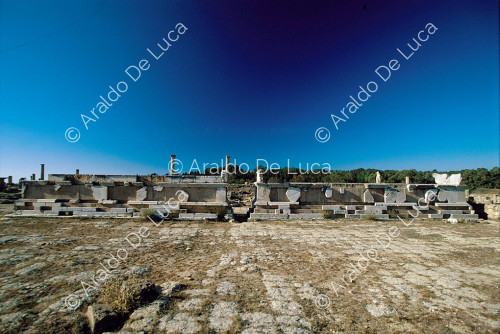Monumental Altars
The two large marble altars stand aligned in an east-west direction in the central area of the Agora . One, called Altar A, stands almost in the centre of the Lower Platea, facing the overlooking North Portico; the other, called Altar B, flanks the first to the east. The construction of both altars, which are not contemporary, took place in the Hellenistic period, probably in two moments only a few years apart. The older altar, datable between the end of the 4th and the first half of the 3rd century BC, when the public square was already completely regularised, is erected with the main side facing south and not east, as was the norm in Greek times. The two altars are the same in outward structure, but differ in general dimensions, the cut and thickness of the blocks, the finish and the unit of measurement used. An axe of marble blocks runs along the edge of the limestone foundation, forming the euthynteria of the monument and serving as the lower step on the northern side. The elevation consists of a high crepidine of four steps enclosed by parapets, the last of which, wider than the others, serves as a prothysis, and the altar case, formed by a crowning cornice. On the latter, along the southern front, rests an espalier decorated at the top with an ovular frame and, along the sides called 'ears', moulded along the edge of the outer gaccia and decorated at the base with acanthus leaves. Altar B, built in imitation of Altar A, but with greater caution in the use of marble and even grappling, has the same curvatures in the steps as those used for optical reasons in temple plinths. The two altars collapsed in the earthquake of the late 3rd century. The marble blocks of the outer facing and the limestone blocks of the inner core were re-used in the late masonry of some buildings. Some elements have even been found in the Sanctuary of Apollo, in the Central Quarter and on the Acropolis.


